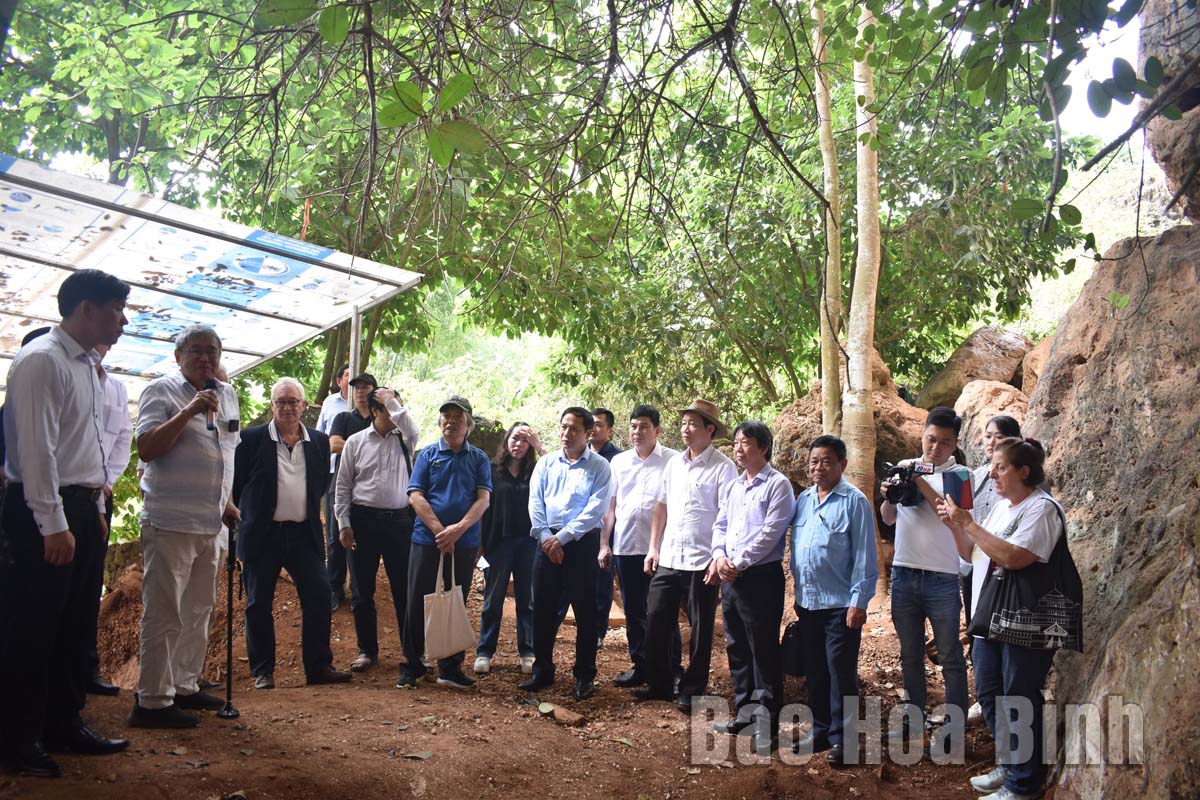
(HBO) – The organising board of a workshop marking 90 years since the world’s recognition of the Hoa Binh Civilisation held a tour of some typical archaeological sites of this civilisation on November 22. Participants included officials of the Ministry of Culture, Sports and Tourism, the ministry’s Cultural Heritage Department, the Institute of Archaeology, the Vietnam Archaeological Association, and domestic and foreign scientists. Vice Chairman of the Hoa Binh provincial People’s Committee Nguyen Van Toan, officials of some departments and sectors, and representatives of the Lac Son district People’s Committee also joined the delegation.

The delegation visits the Vanh Village stone shelter,
a relic site in Yen Phu commune of Lac Son district.
The delegation visited the Trai Hamlet cave in
Tan Lap commune and the Vanh Village stone shelter in Yen Phu commune, which
are typical archaeological sites of the Hoa Binh Civilisation. The Trai Hamlet
cave, discovered in 1975, has been excavated and studied for many years.
Research findings show that it dates back to the Hoa Binh Civilisation in the
Stone Age. In 2001, it was recognised as a national archaeological site.
Scientists found entrances to the cave in 2004 and 2008. Aside from stone tools
and food vestiges typical for the Hoa Binh Civilisation, many beautifully
decorated ceramic pieces and sharpened axes dating back 3,500 - 3,200 years
have also been unearthed at this cave.
Meanwhile, the Vanh Village stone shelter was
found by French archaeologist M. Colani in 1929 during an archaeological survey
of the southern limestone mountain area of Hoa Binh province. As many as 951
objects were collected there. In addition to hewn tools, a large number of
sharpened tools and stone bracelets were also discovered. According to the
study results announced in 1930, this relic site dates back about 17,000 -
8,000 years and belongs to the Hoa Binh Civilisation. Therefore, it was
classified as a site of the middle period of the civilisation.
During the tour, Dr. Nguyen Viet, Director of
the Centre for Prehistoric Southeast Asian Studies, updated participants on the
2022 excavation, which has given a further insight into the Hoa Binh
Civilisation. The latest research efforts revealed that this civilisation was
much older and more diverse than what have been known so far. Given this, more
interesting findings are expected in the future./.
The clothing of women reflects the culture of the Muong, Thai, Tay, Dao, and Mong ethnic groups in the northern province of Hoa Binh.
Gongs hold a special place in the cultural and spiritual life of the Muong ethnic people in Hoa Binh province. More than musical instruments, they are an indispensable part of community rituals and collective memory, echoing through generations as a spiritual thread linking the past, present, and future.
Preserving and promoting the cultural values of the Muong ethnic group has become an urgent task in the current context, as many traditional values face the risk of fading away. This effort requires not only protecting the cultural identity but also eliminating outdated customs and developing a modern cultural lifestyle, contributing to sustainable values for the Muong community in Hoa Binh province.
The Muong ethnic culture, deeply rooted in Vietnam’s mountainous north, continues to be preserved and revitalised by dedicated individuals and communities determined to safeguard their ancestral identity.
The Muong group is one of the largest ethnic minorities in Vietnam, primarily found in Hoa Binh province. The Muong people in Hoa Binh boast a rich and diverse cultural treasure that reflects the unique identity of this ethnic group. Accounting for over 63% of the province's population, they have created and preserved numerous distinctive cultural values, contributing to their unique identity. Their cultural heritage is an invaluable asset, at the heart of their national identity, and represents a vibrant spiritual life that must be preserved and promoted in today’s modern world.
For generations, the ethnic communities of Hoa Binh province, particularly the Muong people, have preserved vibrant festivals deeply intertwined with the region’s geography, nature, and social traditions. These celebrations enrich Hoa Binh’s spiritual life and cultural identity, reflecting both folk beliefs and the intermingling of ethnic customs. Many of these festivals have endured the test of time, passed down through generations and continuing to thrive today. Among them, the Khai Ha (Going Down to the Field) festival stands out as one of the most significant events of the Muong ethnic group.



